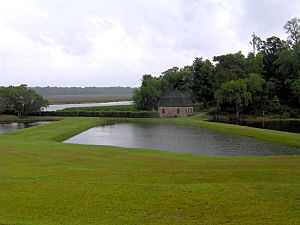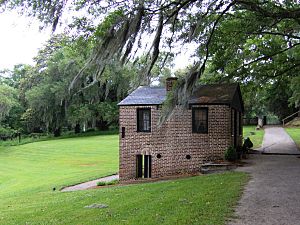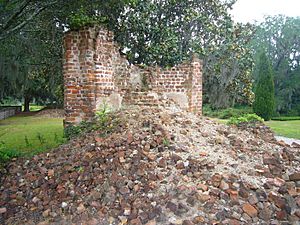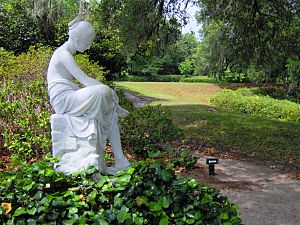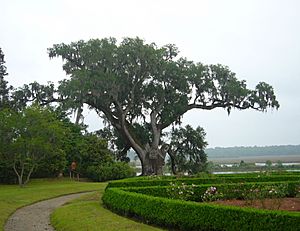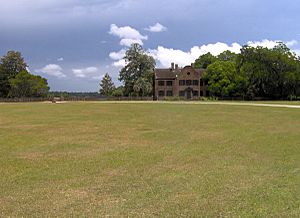Middleton Place facts for kids
|
Middleton Place
|
|

The house museum, initially a guest wing
|
|
| Nearest city | Summerville, South Carolina - Charleston, South Carolina |
|---|---|
| Area | 110 acres (45 ha) |
| Built | c.1738—1755 |
| Architectural style | Colonial |
| NRHP reference No. | 71000770 |
Quick facts for kids Significant dates |
|
| Added to NRHP | May 6, 1971 |
| Designated NHLD | November 11, 1971 |
Middleton Place is a famous historic estate located in Dorchester County, South Carolina. It sits right by the Ashley River, about 15 miles (24 km) northwest of downtown Charleston, South Carolina. This special place was built over many years in the 1700s and 1800s.
Middleton Place was the main home for many generations of the Middleton family. This family played a big part in the early history of South Carolina, both before and after the United States became a country. Today, Middleton Place is a National Historic Landmark District. It's open as a museum and is home to the oldest landscaped gardens in the entire United States!
John Williams, an early South Carolina landowner, likely started building Middleton Place in the late 1730s. His son-in-law, Henry Middleton (1717–1784), later became President of the First Continental Congress. Henry finished the main house and its side buildings, and he began creating the amazing gardens.
Henry's son, Arthur Middleton (1742–1787), was a Founding Father and signed the United States Declaration of Independence. Arthur was born at Middleton Place and lived there later in his life. His son and grandson, also named Henry Middleton (1770–1846) and Williams Middleton (1809–1883), helped turn Middleton Place into a busy rice farm.
Sadly, in 1865, near the end of the American Civil War, soldiers from the Union army burned most of the main house. Only the south side wing and the damaged walls of other parts remained. Later, in 1886, a big earthquake in Charleston knocked down more of the ruined walls.
The gardens at Middleton Place started to be restored in 1916. A Middleton family member, John Julius Pringle Smith, and his wife, Heningham, spent many years carefully rebuilding them. They also had new buildings designed, using bricks saved from the ruined main house. In the early 1970s, about 110 acres (45 ha) of the estate, including the south wing, gardens, and other buildings, became part of the National Register of Historic Places. Around the same time, the Middleton family created the non-profit Middleton Place Foundation. This foundation now takes care of the historic site for everyone to enjoy.
Contents
Exploring Middleton Place's Location
Middleton Place is located on the southwest bank of the Ashley River. The river here makes a sharp turn towards the east. It then flows about 15 miles (24 km) downstream to Charleston Harbor. A small creek, which was dammed to create the plantation's rice mill pond, flows into the Ashley River at this bend. This creek forms the southern edge of the historic area.
Ashley River Road (part of South Carolina Highway 61) runs along the western side of the historic district. This road connects Middleton Place to Charleston in the southeast. The plantation's south wing and living area are on top of a hill. This hill is over 20 feet (6 m) above the river. From here, you can see the river clearly for almost a mile!
A Look Back at Middleton Place's History
Early Days and the American Revolution
Middleton Place was started in the 1730s by John Williams, a wealthy landowner in South Carolina. He probably began building the main house, choosing the spot for its great view of the Ashley River. After Williams passed away, the estate became part of his daughter Mary Williams's wedding gift.
In 1741, Mary Williams married Henry Middleton. That's how the plantation got its name! Henry's father had moved from Barbados and started another estate nearby. Henry became one of South Carolina's richest landowners. At one point, he owned many properties and had many people working on his farms.
Henry likely planned Middleton Place more as a country home than a busy rice farm. The first main house, finished around 1741, was three stories tall and made of brick. In 1755, Henry added two separate two-story buildings, called "flankers," to the north and south sides of the house. The north building held a library and a ballroom. The south building was used as a guest house.
Henry started working on the plantation's gardens in 1741. He wanted his gardens to be more impressive than his neighbors'. He hired an English gardener named Simms. They used ideas from a popular garden book to create the beautiful designs. They made a main path from the house, leading to six shaped grass terraces. Near the river, they dug two lakes, known as the "Butterfly Lakes." These lakes were next to a raised path. The area also included a stream that was dammed to create the long, narrow Rice Mill Pond.
After Mary Middleton died in 1761, Henry moved and gave Middleton Place to his son, Arthur. In 1776, when the American Revolution began, Arthur signed the Declaration of Independence. Four years later, British soldiers attacked Charleston. They searched Middleton Place, damaging statues and stealing art and furniture. Arthur Middleton was captured and held prisoner until 1781. In 1783, the agreement that ended the war in the Southern colonies was signed at Middleton Place.
Life Before the Civil War
Records show that Middleton Place brought in water buffalo from Constantinople in the late 1700s. These were the first in the United States! They were used as experimental farm animals, especially good for working in the muddy fields where rice grew.
In the gardens, Arthur's son, Henry Middleton, became friends with a French plant expert named André Michaux. This friendship led to the first camellia flowers grown in an American garden. Michaux gave them as a gift during his visit in 1786. Three of the four original camellia plants still survive today, grown to 15 feet (4.6 m) tall! One is a "reine des fleurs" camellia, and another is an ancestor of a modern type called Charles Sprague Sargent.
The second Henry Middleton made the gardens even better. He brought in the first Asiatic azalea and the crape myrtle, which is one of the oldest in America. He also filled greenhouses with exotic plants. This made Middleton Place feel like a botanical garden before the Civil War.
When Henry Middleton died in 1846, Middleton Place went to his son, Williams Middleton. In 1860, Williams Middleton signed the South Carolina Ordinance of Secession. This meant South Carolina declared it was no longer part of the United States. This action led to the Battle of Fort Sumter in April 1861, starting the U.S. Civil War.
In February 1865, near the end of the war, Union troops took over Middleton Place. They burned the main house and the north side building. They also damaged part of the south side building. The soldiers also killed some of the water buffalo and took others. These later ended up in the Central Park Zoo.
In 1868, Williams Middleton fixed the roof of the south side building at Middleton Place. He made it the new main home. However, he didn't have enough money for big repairs. After he died in 1883, Middleton Place went to his wife, Susan. Three years later, the Charleston earthquake knocked down the remaining walls of the main house and north side building. It also damaged the gardens even more. The gardens were left uncared for many years after that.
Bringing Middleton Place Back to Life
Williams Middleton's daughter, Elizabeth, inherited Middleton Place in 1900. She made some small repairs. When she died in 1915, she left the estate to her cousin, John Julius Pringle Smith. Smith and his wife, Heningham, used Middleton Place as their winter home. They were determined to bring the gardens back to their original beauty. The Smiths worked for many years, replanting and redesigning the gardens. They opened the gardens to the public in the late 1920s. In 1941, the Garden Club of America called the Middleton Place gardens "the most interesting and important garden in the United States."
In the 1930s, the Smiths began restoring the house and other buildings. They wanted them to look like they did in the late 1700s. In 1971, Middleton Place was added to the National Register of Historic Places. It was also named a National Historic Landmark District. Soon after, the Middleton Place Foundation was created. Smith's grandson, Charles Duell, became its first president. In recent years, the Foundation has done a lot of research. They have documented the thousands of African-American people who worked on the Middleton family's lands.
Middleton Place Today: What to See
Exploring the Estate's Design
The original way to get to Middleton Place was a road that went east from Ashley River Road. It ended in a large loop. The main house (now just the south side building) was at the east end of this loop. The stables were at the south end, and the family burial grounds and main garden area were at the north end. The beautiful terraced gardens and butterfly ponds were east of the main house. The original road, the main gate, and the raised path between the two Butterfly Lakes all lined up perfectly on an east-west path.
The northwest part of Middleton Place has a thick forest that turns into a marsh near the river. This natural area is separated from the north gardens by a long, rectangular pool. This pool is about 800 feet (240 m) long and 100 feet (30 m) wide, and it's called the Reflection Pool. There's also a smaller pool called the Azalea Pool on the north side. The north gardens are laid out like a grid, with hedges and walkways separating each section. On the east side of the gardens, there's a "spoked wheel" shape about 100 feet (30 m) across. Perhaps the most famous part of the gardens is the "Middleton Oak," or "Great Oak." This huge live oak tree has a trunk more than 10 feet (3 m) wide!
The east gardens stretch eastward from the main house for about 200 feet (60 m). Then they go down in a series of terraces to the Ashley River floodplain. Two matching ponds at the bottom of the terraces look like butterfly wings. That's why they are called the "Butterfly Lakes." Raised paths separate the ponds from the river to the north and from the mill pond to the south. A smaller garden, about 150 feet (46 m) by 150 feet (46 m), sits between the north and east gardens. It's divided into four even smaller gardens.
Most of Middleton's 6,000 acres (2,400 ha) is forest. In 2013, half of the property was set aside for a special program. This program helps reduce carbon in the atmosphere and ensures the land will not be developed.
The Middleton Place House (South Flanker)
The Middleton Place House, which used to be the south wing, was built in 1755 by Henry Middleton. One stone in the house even has his initials and the year "1755." The roof was added in 1868. This was after the original roof was destroyed when Union soldiers burned the property. The house is two stories tall, about 52 feet (16 m) by 20 feet (6 m). It has a pointed roof and decorative stepped gables. A service wing, about 18 feet (5.5 m) by 28 feet (8.5 m), was added to the south side in the 1930s. This wing was built to match the 18th-century style of the house. The first floor of the house originally had a parlor, living room, and dining room. The second floor had three bedrooms. Today, the inside is decorated with original furniture from that time.
Other Interesting Buildings
- The Middleton Place rice mill is located just east of the Butterfly Lakes. It's where a natural stream flows into the Ashley River. Williams Middleton built this mill in 1851 when he started more intense farming at Middleton Place. The mill has been changed a few times over the years.
- The Middleton Place springhouse, located behind the south side building, was built in the 1700s. Springhouses were used like early refrigerators to keep food cool. In 1850, the second floor of the springhouse was turned into a chapel.
- Eliza's House is a home built around 1870 for a freed person. It's named after its last resident, Eliza Leach (1891–1986).
- The Stableyard is an area where you can see demonstrations. It includes a barnyard and stable, both built in the 1930s.
Images for kids
See also




